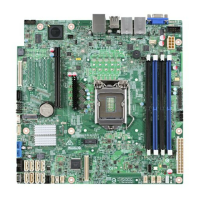Intel® Server Board S1200SP Family Technical Product Specification
46
• Low or out-of-memory condition – The platform management subsystem will reset itself upon detection
of this condition.
The BMC watchdog feature only allows up to three resets of the BMC CPU (such as HW reset) or entire FW
stack (such as a SW reset) before giving up and remaining in the uBOOT code. This count is cleared upon
cycling of power to the BMC or upon continuous operation of the BMC without a watchdog-generated reset
occurring for a period of greater than 30 minutes. The BMC FW logs a SEL event indicating that a watchdog-
generated BMC reset (either soft or hard reset) has occurred. This event may be logged after the actual reset
has occurred. Refer to sensor section for details for the related sensor definition. The BMC will also indicate a
degraded system status on the Front Panel Status LED after a BMC HW reset or FW stack reset. This state
(which follows the state of the associated sensor) will be cleared upon system reset or (AC or DC) power cycle.
Note: A reset of the BMC may result in the following system degradations that will require a system reset or
power cycle to correct:
1. Timeout value for the rotation period can be set using this parameter. Potentially, there will be incorrect
ACPI Power State reported by the BMC.
2. Reversion of temporary test modes for the BMC back to normal operational modes.
3. FP status LED and DIMM fault LEDs may not reflect BIOS detected errors.
6.6 Fault Resilient Booting (FRB)
Fault resilient booting (FRB) is a set of BIOS and BMC algorithms and hardware support that allow a
multiprocessor system to boot even if the bootstrap processor (BSP) fails. Only FRB2 is supported using
watchdog timer commands.
FRB2 refers to the FRB algorithm that detects system failures during POST. The BIOS uses the BMC watchdog
timer to back up its operation during POST. The BIOS configures the watchdog timer to indicate that the BIOS
is using the timer for the FRB2 phase of the boot operation.
After the BIOS has identified and saved the BSP information, it sets the FRB2 timer use bit and loads the
watchdog timer with the new timeout interval.
If the watchdog timer expires while the watchdog use bit is set to FRB2, the BMC (if so configured) logs a
watchdog expiration event showing the FRB2 timeout in the event data bytes. The BMC then hard resets the
system, assuming the BIOS-selected reset as the watchdog timeout action.
The BIOS is responsible for disabling the FRB2 timeout before initiating the option ROM scan and before
displaying a request for a boot password. If the processor fails and causes an FRB2 timeout, the BMC resets
the system.
The BIOS gets the watchdog expiration status from the BMC. If the status shows an expired FRB2 timer, the
BIOS enters the failure in the system event log (SEL). In the OEM bytes entry in the SEL, the last POST code
generated during the previous boot attempt is written. FRB2 failure is not reflected in the processor status
sensor value.
The FRB2 failure does not affect the front panel LEDs.

